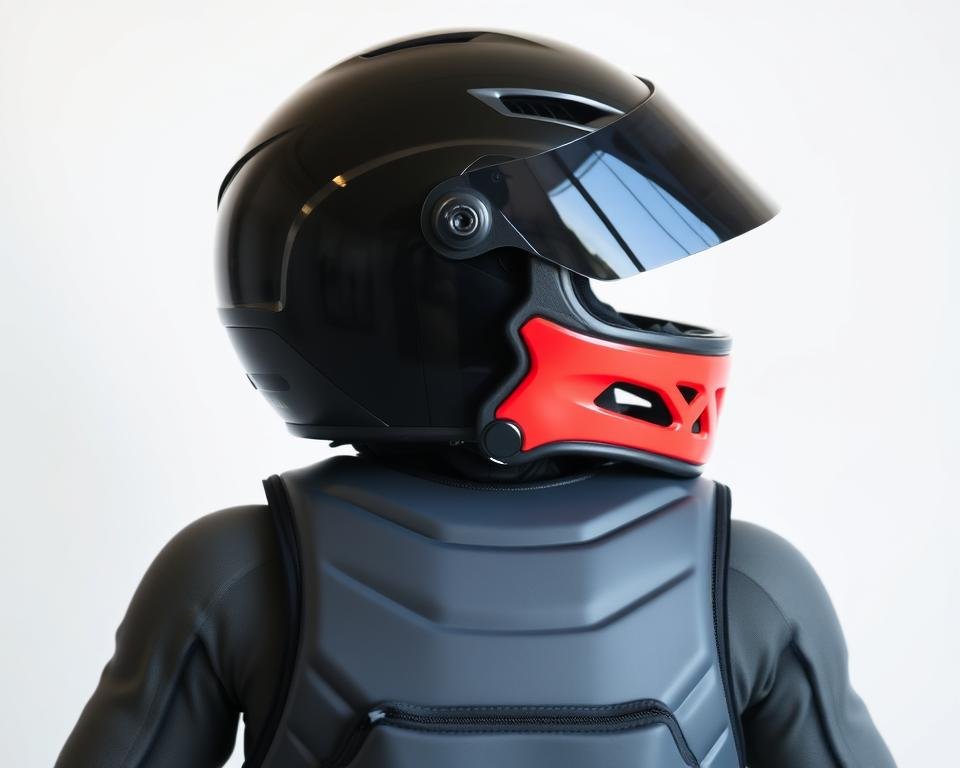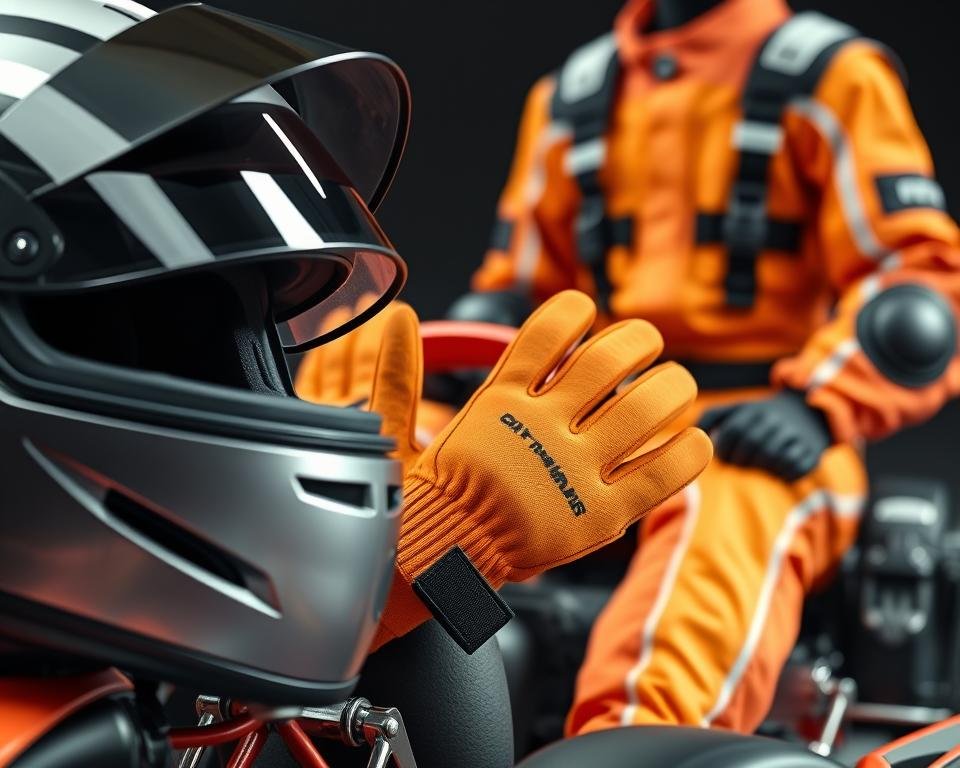Over 10,000 karting injuries occur yearly in the U.S., turning what seems like a casual activity into a high-stakes sport. Even racing legends like Ayrton Senna and Michael Schumacher began their careers in karts, where protective equipment wasn’t optional—it was survival. Whether you’re racing competitively or testing a kart in your driveway, the risks remain real.
Karts sit low to the ground, exposing drivers to flying debris and direct impacts from uneven tracks. Without suspension systems, every bump transfers energy straight to your body. Speeds can exceed 60 mph, yet many underestimate the need for proper head-to-toe protection during casual sessions.
This guide walks you through critical items like helmets, fire-resistant suits, and reinforced gloves. Brands like Simpson and Zamp offer options for all budgets, proving cost shouldn’t compromise safety. You’ll learn how each piece works together to shield you from harm, ensuring you return home unharmed after every session.
Prioritizing quality gear isn’t just about compliance—it’s about respecting the sport’s demands and protecting what matters most. Let’s explore how to build your defense system against the track’s unpredictable challenges.
Introduction to Karting Safety and Its Importance
Modern karting combines adrenaline with engineering advancements, yet its open-wheel design keeps risks ever-present. Unlike cars with protective shells, drivers sit inches from spinning wheels and unpredictable track surfaces. This reality makes specialized equipment non-negotiable—even for casual participants.
Understanding the Risks on the Track
Karting’s thrill comes from tight corners and wheel-to-wheel racing. But those close battles often lead to collisions. Without seatbelts or roll cages, your body absorbs every impact. Debris from tires or loose bolts becomes airborne hazards at 50+ mph.
Even skilled drivers face flipped karts or sudden stops. Lightweight frames lack crumple zones, transferring force directly to your ribs and spine. Tracks vary too—uneven asphalt or weather changes multiply dangers instantly.
The Role of Safety Gear in Preventing Injuries
Quality equipment does more than meet regulations. Fire-resistant suits deflect sparks during slides, while rib protectors cushion side impacts. Brands like Sparco design gloves with reinforced palms to improve grip without sacrificing protection.
Helmets certified for karting reduce concussions during crashes. Neck braces stabilize your head during sharp turns, letting you focus on driving precision. Together, these layers create a defense system trusted by professionals worldwide.
Essential Safety Gear for Every Go-Kart Driver
Karting demands more than skill—it requires a defense system built from specialized components. Eight critical items work together to shield you from impacts while enhancing control. Let’s break down this layered approach to track safety.
Core Components for Full-Body Protection
Your helmet is the frontline defense, shielding your head from collisions and debris. Look for models with SA2020 certification—they’re tested for karting’s unique impacts. Pair it with a neck brace to stabilize your head during sharp turns that generate 2-3G forces.
Rib protectors combat lateral pressures from the seat’s tight fit. Modern designs use breathable foam or carbon fiber to absorb shocks without restricting movement. Combine these with fire-resistant suits that repel sparks during slides—brands like Sparco offer lightweight options with moisture-wicking liners.
Precision Control Add-Ons
Gloves with reinforced palms improve steering grip while cushioning vibrations. Racing shoes feature thin soles for better pedal feedback—Alpinestars’ models balance protection with tactile sensitivity. Don’t overlook underlayers: balaclavas prevent helmet chafing, while fireproof underwear adds critical seconds during emergencies.
Each piece enhances performance as it protects. Properly fitted racing equipment lets you push limits confidently, knowing you’re guarded against karting’s unpredictable nature. Up next: how to choose helmets and torso protectors that match your driving style.
Helmets, Neck Braces, and Rib Protectors: Protecting Your Head and Torso
Your head and torso face constant forces in karting, from high-speed impacts to lateral G-forces. Three components form your primary defense: helmets, neck braces, and rib protectors. Each serves distinct roles while working together to absorb shocks and maintain control during races.

Choosing the Right Helmet: Certification and Fit
SA2020-certified helmets are the gold standard—they undergo rigorous impact and fire tests motorcycle gear skips. For drivers under 15, CMR2016-rated models ensure proper head protection scaled to younger physiques. A snug fit matters: your helmet shouldn’t shift when shaking your head. Brands like Bell and Arai offer oval or round shapes to match your skull profile.
Neck Braces and Their Benefits for High G-Forces
Karting’s sharp turns generate 3G lateral forces—enough to strain your neck muscles. A quality brace stabilizes your head, reducing fatigue during 20-minute races. Look for designs with extra rear padding to match the 30-degree seat recline. This support lets you focus on steering precision rather than fighting whiplash effects.
Rib Protectors: Carbon Fiber vs. Foam Options
Carbon fiber rib protectors outperform foam with flexible yet rigid panels that wrap around your torso. They absorb side impacts from seat bolsters during collisions. Foam works for casual use, but racers prefer carbon’s blend of comfort and protection. Either choice beats nursing fractured ribs for months after a crash.
Racing Suits, Gloves, and Shoes: Gear for Optimal Performance and Comfort
Your choice of trackwear directly impacts both safety and lap times. While helmets guard your head, your racing suit, gloves, and shoes form a critical triad for managing heat, friction, and pedal precision.
Fireproof Racing Suits vs. Abrasion Resistant Karting Suits
Traditional karting suits use Cordura fabric to prevent road rash during slides. These prioritize abrasion resistance over fire protection—ideal for open-wheel karts where quick exits are possible. For cage karts with harnesses, SFI-certified fireproof suits become mandatory. Their flame-retardant layers buy crucial seconds if fuel fires occur.
Fit matters: loose suits snag on components, while tight ones restrict steering movements. Measure your chest and hips when standing—not sitting—to ensure mobility without excess fabric.
Enhancing Grip and Control with Quality Gloves and Shoes
Karting gloves feature silicone grips and padded palms to dampen vibrations from direct-steering systems. Reinforced knuckles protect against impacts during collisions. Pair them with racing shoes—their thin soles let you feel pedal resistance changes instantly.
Unlike sneakers, specialized shoes have narrow profiles to avoid cockpit interference. Stiff ankle supports prevent twists during aggressive cornering. This combo keeps your inputs precise when milliseconds decide positions.
Best Practices for Equipment Fit, Certification, and Maintenance
Proper karting protection requires more than purchases—it demands precision in fit and compliance with evolving certification rules. Tracks and racing series enforce different standards, so gear that works at one venue might fail inspection elsewhere. Start by measuring your body in racing positions, not standing upright, since posture changes during driving.
Ensuring a Proper Fit for Maximum Protection
Ill-fitting equipment creates dangerous gaps during crashes. Helmets should sit snug without pressure points—test by shaking your head side-to-side. Suits require extra size allowances for rib protectors and knee pads. Brands like Sparco recommend sizing up if you’re between measurements.
Always try gloves and shoes with your full racing outfit. Tight sleeves restrict steering, while loose footwear reduces pedal control. Replace gear showing wear in stitching or abrasion zones—even minor damage weakens protection over time.
Understanding Certification Standards (SA/FIA, SNELL, and CMR)
SA2020-certified helmets meet U.S. impact tests, while FIA standards govern European tracks. Dual-certified gear saves time if you race internationally. For drivers under 15, CMR2016 ensures lighter, youth-proportioned equipment.
Some circuits now mandate FIA-rated suits over SFI versions. Check event rules before buying—high-tier certifications often cost 20-30% more but prevent last-minute disqualifications. Always verify expiration dates; most certifications expire after five years.
Advanced Tips and Additional Gear for the Track
Maximizing performance while staying protected requires smart layering and track-tested accessories. Beyond core equipment, these additions address heat management and emergency scenarios—factors that separate prepared drivers from the rest.
Layering and Underwear for Extra Fire Protection
Fire-retardant underwear upgrades any suit’s capabilities. Paired with abrasion-resistant gear, it creates dual protection against road rash and flames. SFI-certified suits gain 8-10 extra seconds of burn resistance when layered over these base garments—critical time to exit a kart safely.
Non-fireproof suits become track-legal in many series when worn over certified underlayers. Look for moisture-wicking fabrics that manage sweat during long races without compromising safety ratings.
Other Accessories: Balaclavas, Head Socks, and More
Balaclavas shield your neck and face from helmet chafing while absorbing sweat. Pair them with fire-resistant socks to protect feet from hot pedal assemblies. These often-overlooked items prevent distractions, letting you focus on racing precision.
Seat padding inserts customize cockpit fit, reducing fatigue during endurance events. Glove liners improve grip without adding bulk—ideal for drivers with smaller hands. Every layer should enhance comfort and safety, never compromise either.

